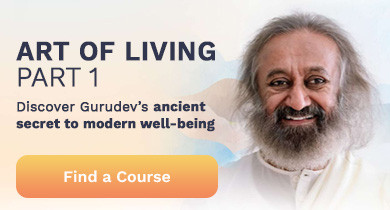By Volunteer Writer
Bhakti yoga, or the yoga of devotion, is all about surrender to the divine. Learn how to begin this transformative practice and walk the path of devotion.
"Those who fix their mind on me and only I dwell in their thoughts; and who sing my glories with love and devotion; and who have complete faith in me are the best."
~ Lord Krishna on Bhakti Yoga, Bhagavad Gita
In the above quotation, Lord Krishna answers Arjuna's question in the sacred text known as Bhagavad Gita, on who is an ideal Yogi - one who is in complete union with and devotional service to the Divine. It’s truly the essence of Bhakti Yoga.
What is Bhakti Yoga?
Bhakti Yoga is a Sanskrit phrase; yoga comes from the Sanskrit root yuj and means union, and some English words and phrases that could possibly serve as translations for Bhakti include "Love," “Devotional Love,” "Universal Love," “Pure Love,” and "Divine Love."
Bhakti is what we are, not what we do or have. Waking up to that realization is Bhakti Yoga, an understanding of the Supreme Consciousness is everything, and nothing else exists. With this awareness, the yogi who becomes a bhakti yogi, or bhakta, drops any sense of separateness from that all-pervading power, loses all identities defined by the world, and merges, as though diving into a vast, infinite ocean of all-encompassing, supreme, love.
Bhakti Yoga, the lively feeling of oneness, is also known as a path of devotion, leading to self-realization rooted in intense love, and to a state of complete surrender to God.
Bhakti yoga tradition, as a form of union with the infinite, must be as old as human civilization. Formally, it got recognized as a way of expressing intense devotion for God in Shvetashvatara Upanishad. Much later, Bhagavad Gita portrayed it as a "marga," or a path to realizing the Ultimate Truth. It is elucidated further in Bhagwatam, as aphorisms made by Narada, in Narada’s Bhakti Sutras.
Understanding the real meaning of Bhakti
The word “bhakti” is a Sanskrit term meaning devotion. In this word, “bha” stands for fulfillment and nourishment, “ka” signifies knowing, “ta” means salvation and “i” (ee) indicates shakti or energy.
It’s hard to define Bhakti; one can feel it, realize it. With every breath, we sow the seeds of Bhakti, a love that sweeps us away beyond egoism, helps us to soar above the world, and changes us forever, touching the deepest core of our existence, our soul.
Bhakti is not about seeking that love but dropping the barriers against it that we’ve built inside ourselves. It opens the door to eternity within. It’s the love that shines in our eyes as the light of our soul. Bhakti wakes us up to total worship, as we start to realize that everything reflects the Divine.
God's love is unconditional, and devotees acknowledge that love and reflect it back. A yoga practice that includes kirtan (call and response chanting) and mantra meditation are some ways they do so. In Bhakti Yoga, the blossoming of devotion towards God is the sweetest experience one can have.
A practitioner of Bhakti Yoga sees Divinity everywhere, and yet has an intense longing for the Divine.
Bhakti is one of the paths of yoga mentioned in the ancient Indian scriptures and traditional yoga systems and denotes the spiritual practice of lovingly devoting oneself to a personal god or form of God.
How does one practice Bhakti Yoga?
Bhakti is basically a state of heart that is full of love, devotion, and surrender. Many experience Bhakti Yoga through:
Chanting and devotional or prayerful singing.
Being a faithful servant to God.
Japa or keeping an unbroken remembrance of God (Rosary).
Puja or ceremonial expression of gratitude.
Worship of a divine image.
Appreciating the wonder and beauty of nature, seeing it as a manifestation of the Divine.
Setting up an altar with a favorite image or representation of the Divine and offering flowers, fruits, lamps, or incense, or worshiping mentally.
These activities provide a concrete way to acknowledge that Divinity is everywhere and in everything. For everyone, Bhakti Yoga teaches us that love is one’s very own nature, not just an emotion.
By sharing yourself and this god realization, you have the opportunity to multiply the joy and celebration of your own existence in a loving relationship with a Higher Self. With the company of other devotees and yoga practitioners, this joy and celebration take the form of a loving and blissful community.
By surrendering to the love that you are, you can transcend worldly sorrow and pain, and experience total freedom in the simplest way possible.
Mantra chanting
By repetitively chanting sound vibrations, your mind can dissolve and rest, while your spirit takes over. The sounds permeate every cell of your being. You become free from repetitive thoughts. Every mantra means infinity and takes you beyond the cognition of your mind.
Satsang, meaning “company of truth,” is a time and place when devotees on a common spiritual path come together for chanting mantras, a practice also known as “kirtan.”
The ancient Hindu saints simplified Vedic chants into something everyone could easily learn. Doing this out of compassion, they made the powerful sounds of mantras available to all of us. These sounds impact consciousness at a very deep level. By listening to them or chanting them, we become able to communicate more effectively and attain greater clarity in our minds as well as purity in our words, deeds, and thoughts.
Flavors of devotion
Devotion is essentially the same in all devotees. However, ancient wisdom offers many ways to look at devotion, including through relationships with others and focused directing of love to different aspects of Divinity.
For example, in Narada’s Bhakti Sutras, the sage Brahmarishi Narada defines 11 forms of Bhakti. They include:
Loving attributes of the Divine (Mahatmyasakti)
Loving the form of the Divine (Rupasakti)
Worshiping the Divine (Pujasakti)
Constantly remembering the Divine (Smaranasakti)
Serving the Divine (Dasyasakti)
Loving the Divine as a friend (Sakhyasakti)
Loving the Divine as one’s child (Vatsalyasakti)
Loving the Divine as one’s lover (Kantasakti)
Surrendering oneself to the Divine (Atma-nivedanasakti)
Merging in the Divine (Tanmayasakti)
Longing for the Divine (Virahasakti)
Gurudev Sri Sri Ravi Shankar has given a series of 30 beautiful talks on the Bhakti Sutras - Narada’s extensive works on devotion. You can find this wisdom series on the Journey App and at the Art of Living Bookstore. Hearing about Bhakti Yoga directly from a true spiritual master who tells divine stories can illuminate how the path works and how it can be relevant in your daily life.
Surrender to God
When devoted, one can experience the complete absence of fears and worries, allowing the devotee to move beyond mundane problems and difficulties. This experience often takes place when singing kirtan.
A true devotee has no selfish desires, including the desire for liberation. Devotion in one's heart is kindled by the grace of the Guru, being in the company of other devotees, and reading and listening to other devotees’ stories.
“When the river meets the ocean, it recognizes it is the ocean from the beginning to the end. In the same way, the moment a devotee surrenders to the Divine, the devotee becomes Divine.”
~ Gurudev Sri Sri Ravi Shankar
Inspired by Gurudev Sri Sri Ravi Shankar’s wisdom talks.
******************************************************************************************************
Something very precious and beneficial that you can add to your Bhakti practice is to learn SKY Breath Meditation (Sudarshan Kriya®). This ancient breathing practice was realized by Gurudev during 10 days of silence in the early 1980s. In addition to significant mind and body benefits, SKY gives you the proper vision of you are and cultivates Bhakti itself.
Please accept our invitation to attend Beyond Breath, a free online breath and meditation session where you can learn more about SKY Breath Meditation. Click on the image below to choose a day and time that works best for you.
You might also enjoy reading Guru Purnima: Looking Through the Eyes of a Spiritual Seeker.





























